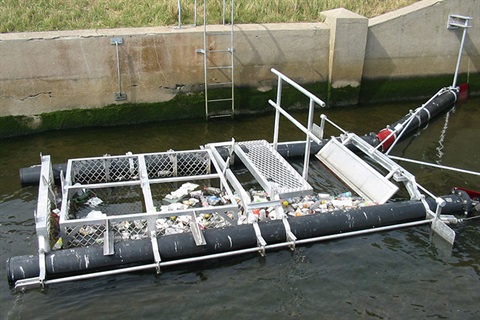How we improve our waterways

We use various treatment devices in the stormwater system. These prevent litter, sediment and pollutants from entering natural waterways. This includes the Derwent Estuary.
The devices stop litter, sediment and other gross pollutants at the entry point to the waterway. This occurs within the catchments, or at the end of the line of a stormwater system – the River Derwent.
These devices target specific types of pollution. They have several unique designs and are placed throughout the catchments.
Litter collection
| Treatment Device |
What it does |
Where we have them |
| Litter sock |
Collects litter which is coming through a pipe. It is attached to the end of a pipe at the outfall. |
The outfall coming from McRobies tip site into Hobart Rivulet, at Degraves St. |
| Floating litter trap |
A device which floats on the surface of an open waterway and catches floating litter. |
Hobart Rivulet outfall at Macquarie Point and the Sandy Bay Rivulet at Quayle Street. |
| In-pit litter traps |
Sits inside kerb pits and acts like a tea strainer, which catches litter and vegetation that flows down the kerb into the drains. |
Placed in stormwater grates within kerbs around the main shopping precincts. Several are installed in Salamanca. |
| Gross pollutant trap |
Large pits which sit inside underground pipes and catches litter above 5mm in size. These traps often have sediment weirs associated to increase the types of pollutants captured. |
Long Beach, below Waterworks Road, and on Maypole Rivulet near Ogilvie High School. |
Sediment collection
Will also capture finer pollutants which bind to the sediment.
| Treatment Device |
What it does |
Where we have them |
| Sediment Weir |
A deeper, or walled, section of the waterway which allows water to pool and sediment to settle, which can then be cleaned out as required. |
Hobart Rivulet near Barrack Street. The boulder trap at Cascade Gardens - functions to collect sediment as well as large natural debris. |
Other pollutant collection
Such as oils, nutrients and heavy metals.
| Treatment Device |
What it does |
Where we have them |
| Rain garden |
A simpler biofiltration system. Water flows into the garden and is captured and filtered by the plants and soil, and flows out the other end. |
Lefroy Street carpark, and at the bottom of Anglesea Street. |
| BioREtention basin |
Water flows into the system, settles into the soil where it is filtered by the plants, then flows into a piped system underground. The water is not intended to remain above ground for an extended period of time. |
Bell Street in front of the Tasmanian Hockey Centre. |
| BioDEtention basin |
Similar system to the bioretention basins, however the water is intended to remain above ground for an extended period of time (e.g. wetlands). |
Garrington Park development, New Town. |
Additional street cleaning
In addition to these devices, the we carry out street cleaning. This cleans our roads before any litter or pollutants get washed into waterways during rain. We use large sweeper trucks, small footpath sweepers, other mechanical sweeping and sweeping by hand.